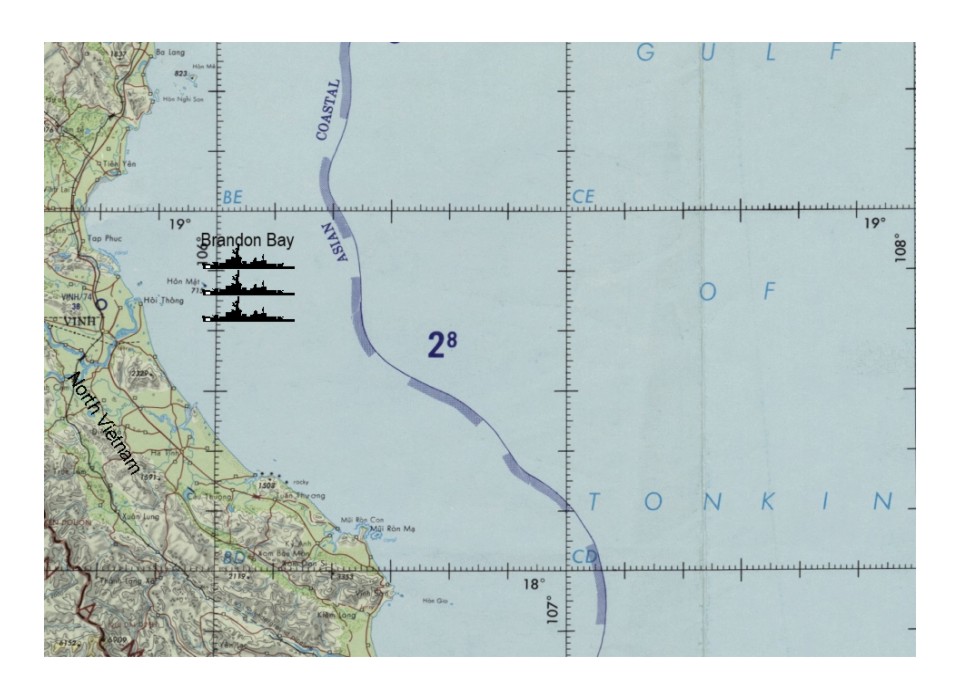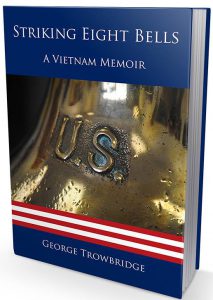Expanded story from: “Striking Eight Bells: A Vietnam Memoir.”
“Another story on what most Americans don’t know about the Navy’s role in the Vietnam War.”
Attack on Vinh by Task Unit 71.1.1
On 11 January 1973, another combat action occurred involving USS Cochrane (DDG 21), USS McCaffery (DD 860), and USS Turner Joy (DD 951) near Vinh, North Vietnam, about 100 miles north of the DMZ. This action, which came to be called “The Battle of Brandon Bay,” was for the three destroyers making up Task Unit 71.1.1, to conduct a coordinated strike from seaward at high speed, with a large number of Air Force B-52s dropping about 900 tons of bombs, followed by an attack from Air Force and Navy fighter-bombers. The goal of the attack was to hit North Vietnamese Army (NVA) troop staging areas and petroleum storage sites in the vicinity of Vinh.

The battle plan had the three ships firing on their final approach leg at about 12,000 yards (6 nautical miles [nm]) from the beach, prior to a high speed starboard turn that would put all ships in a loose line of column. The three ships formed up in a loose line abreast at about 1945, all ships had all four boilers lit off, with split plant operations, ship’s navigation lights were off and at about 2030 all ships went to General Quarters (GQ), and started the 35,000 yards (17.5 nm) run to the gun firing area building up to a speed 32 knots. Once the ships were up to speed, starting at about 28,000 yards (14 nm) from the beach all three ships started running preplanned zigzag legs. Each zigzag leg was about 3,000 yards (1.5 nm) in length. While still on their inbound approach legs, the ships began to starting taking counterbattery fire from the shore, with USS Cochrane and USS McCaffery taking the brunt of it. At 12,000 yards (6 nm) from the beach, all three ships turned to their final approach (zigzag) leg before paralleling the beach and opened fire at the primary targets.[1]


The NVA counterbattery after the destroyer attacks became so intense that after taking the brunt of the NVA counterbattery, the task unit strike commander ordered the high-speed retirement of USS Cochrane and USS McCaffery. Turner Joy was ordered to stay behind long enough to cover the other ships with her 5-inch/54 caliber guns that could put out a rate of fire of 40 rounds per minute. The three ships had been outgunned in sheer numbers of their gun barrels against the enemy’s. The three ships had fought the entire action at speeds over 30 knots, had inflicted maximum damage on the enemy and emerged nearly unscathed.[1]
I recall this attack in part because of the over pressure shockwave that hit our ship, USS Rich (DD 820) from the B-52s dropping their bombs essentially all at once in the target area. Our ship was offshore about 12 to 15 nautical miles out, and the blast shockwaves as they overtook us started with humming sounds from vibrating steel, then built until rattling began and actually shook the entire ship. The early evening sky to our northwest repeatedly lit up with brilliant white and yellow high intensity light flashes from the exploding bombs.

There had to have been direct hits on the petroleum or ammunition storage sites. One massive explosion after another went on for close to 30 minutes. Just before each loud explosive boom could be heard, orange and yellow high intensity light flashes jetted upward into the evening skies. Someone on the bridge asked out loud, “Did someone drop a goddamn nuke?” …..To read “Striking Eight Bells,” use one of the following links to various booksellers: Amazon.com:Books, Barnes and Noble Booksellers, BAM –Books A Million and Smashword.com eBooks

The stories in these posts and the book; “Striking Eight Bells: A Vietnam Memoir,” reflect the author’s recollection of events. Some names, locations, and identifying characteristics have been changed to protect the privacy of those depicted. Dialogue has been recreated from memory. Dates, times, and locations were recreated from declassified U.S. Navy records and others. Photographs used are either public domain or owned by the author. Illustrations and maps used were either created by the author or in the public domain. The stories in these posts and the book are solely the opinion of the author and not the publisher, Richter Publishing, LLC.
*Image was found in public domain or it could not be established after reasonable search, that any claim existed to the image. Image used for illustrative purposes only and is not the property of the author. Where ever possible, credit for the image is indicated in the caption.
- Battle of Brandon Bay. The Last Pitched Surface Gun Battle. LCDR Jim Chester (USN Retired). 14 May 1998.
I was there on uss cochrane in forward gun mount
LikeLike
United States Navy Vietnam Veteran Seventh Fleet here.
LikeLike
i
i was operating the ECM in McCaffery DD 860 that night.
LikeLike
NOVEMBER FOXTROT INDIA TANGO
LikeLike
I was there on the “ BIG MAC “ that night as the GQ helmsman… QM3 Gerald Sweeting
LikeLike
I was fortunate to have served on both these fine Tin Cans!
USS Turner Joy (DD-951)
Sept ’68 – Oct ’71 [2 Westpacs]
USS McCaffery (DD-860)
Oct ’71 – Sept ’72
BM3 Chuck Steele
LikeLike
I was there 50 years ago today. I was on the port side of the bridge calling out bearings of in coming gun flashes, so we could return fire. As flak Metal hit all around me and water spraying from in coming rounds we never took a hit. I was there all four nights. USS McCaffery DD860, Nick Frilling SM3.
LikeLike
I was there Jerry L. Thomas OS1 CIC, McCaffery DD860
LikeLike
Projectile man mount 51 USS McCaffery DD 860 during battle of Brandon Bay. The most intense hours of my life!!
LikeLike